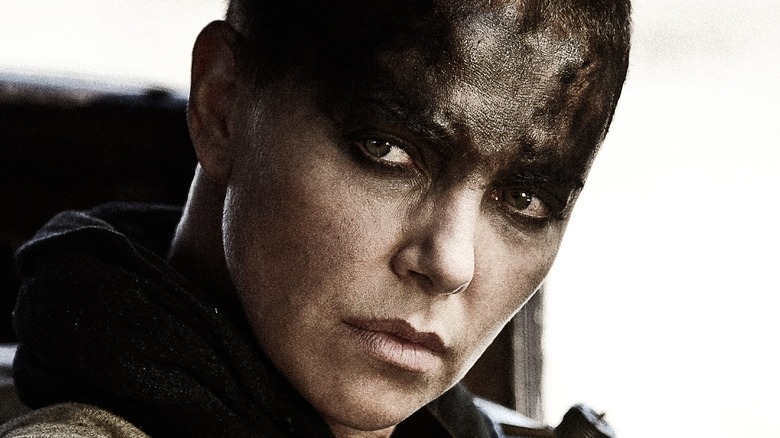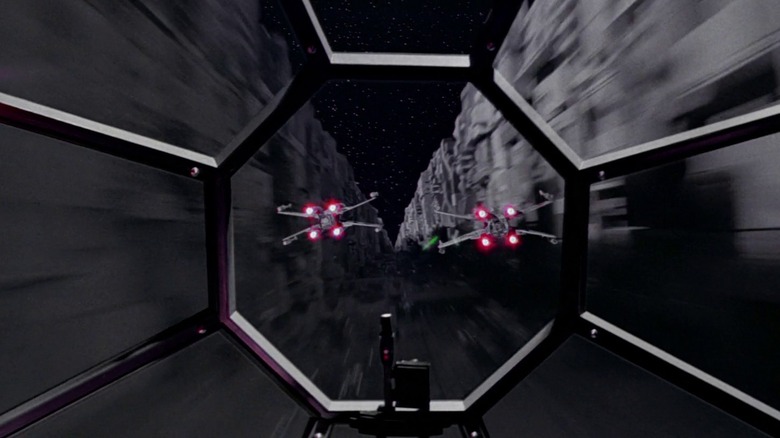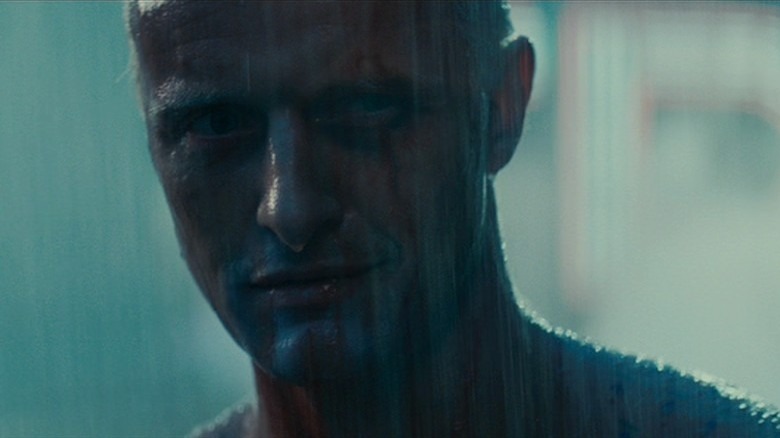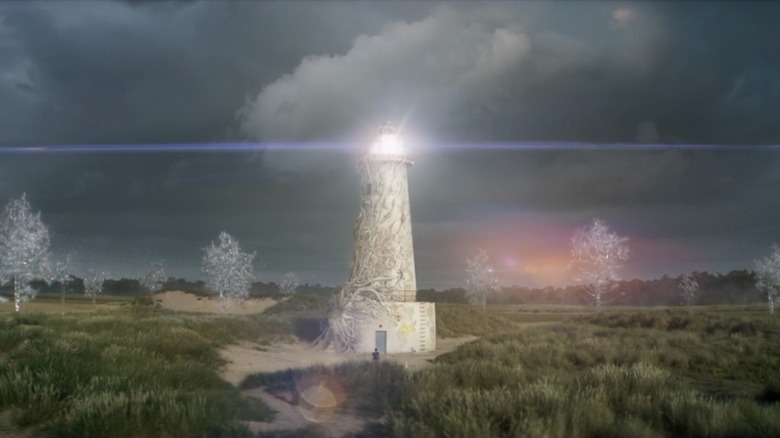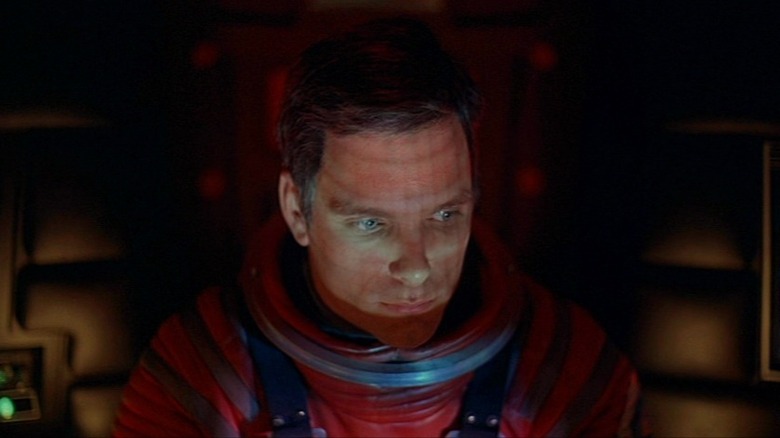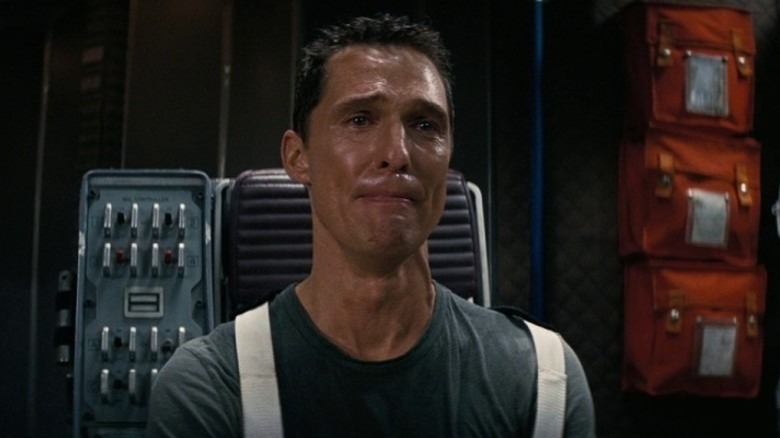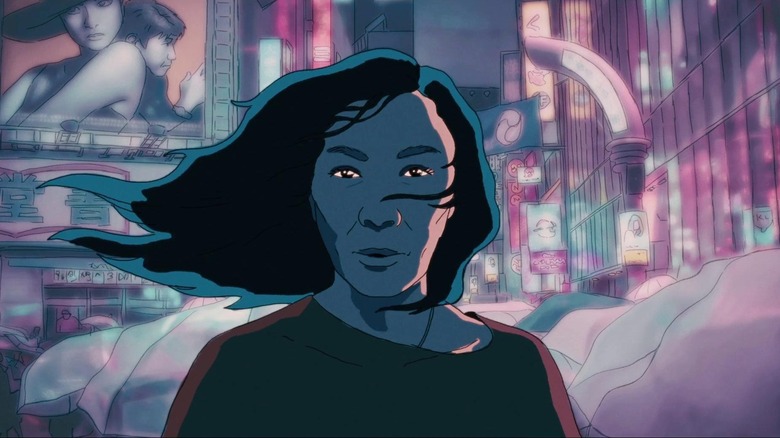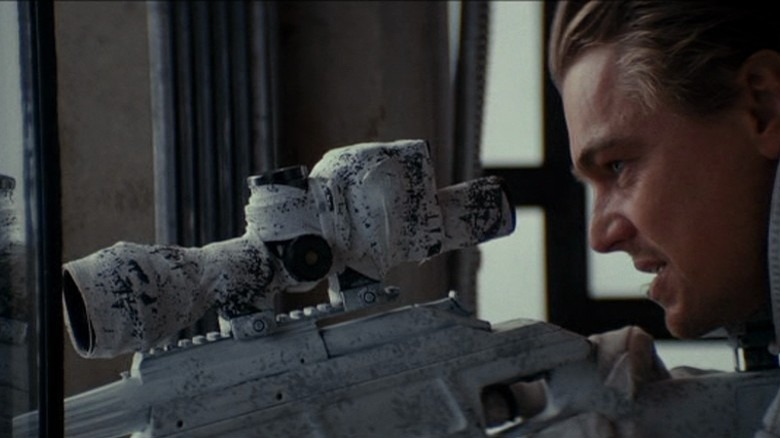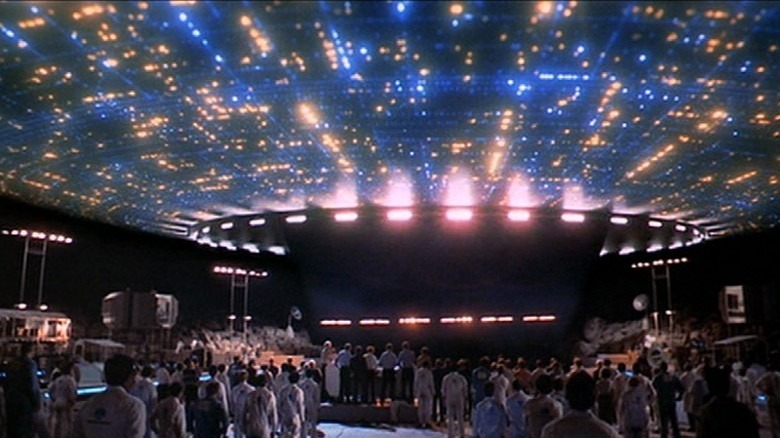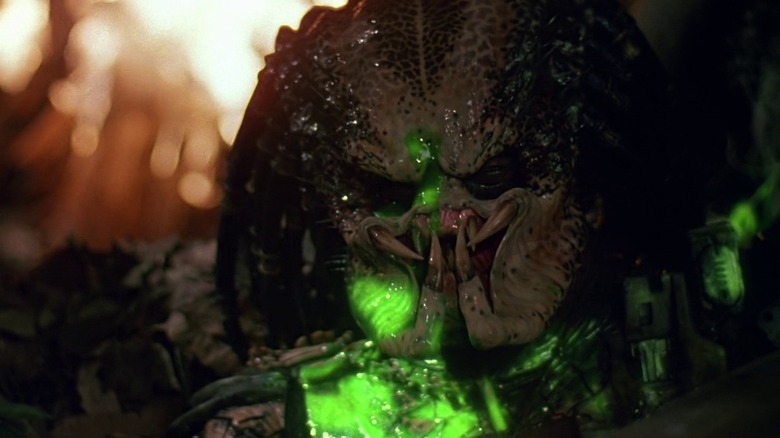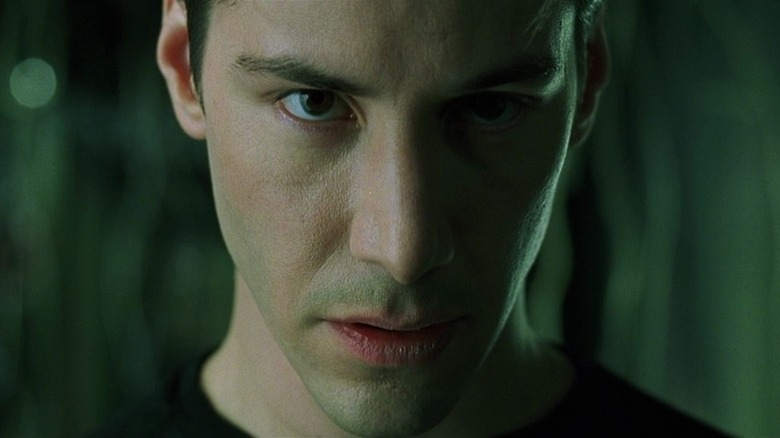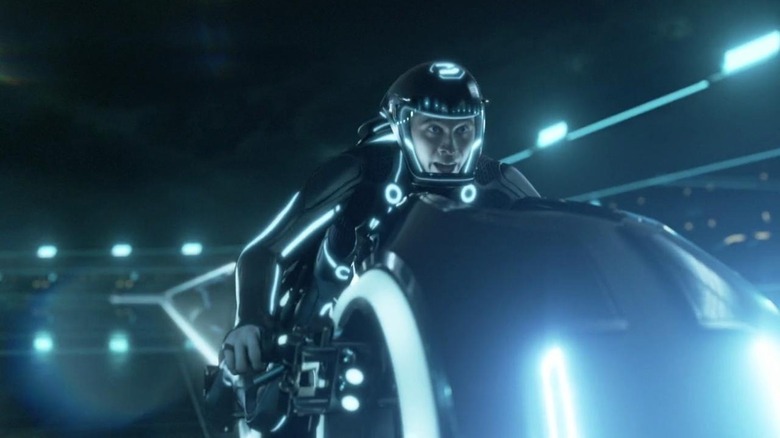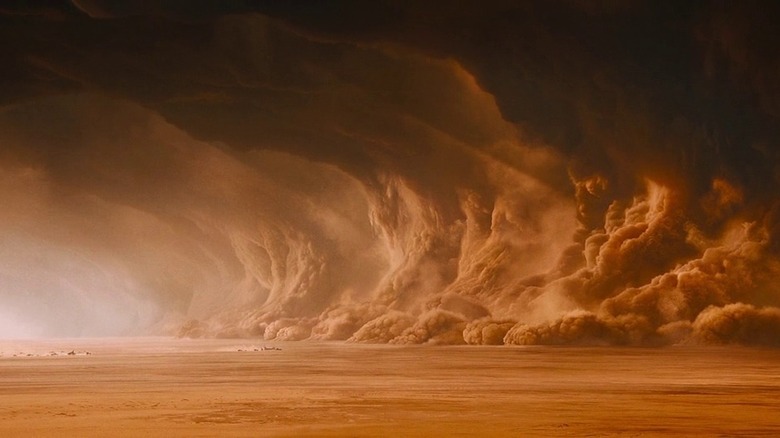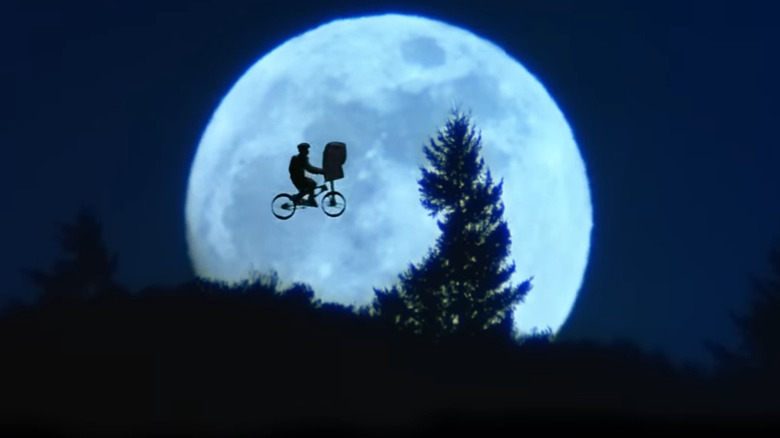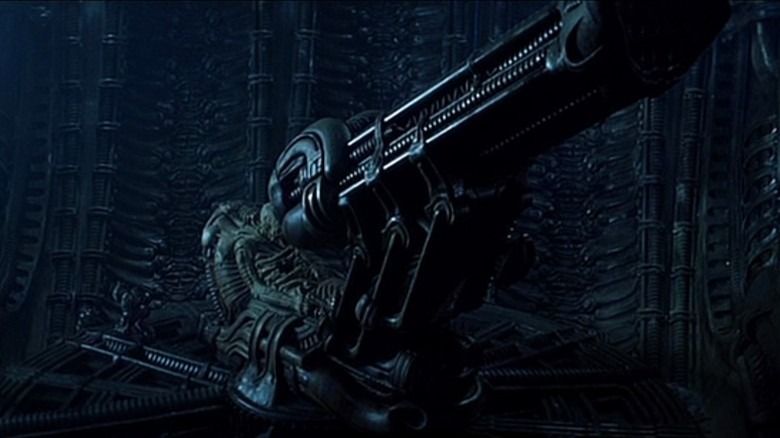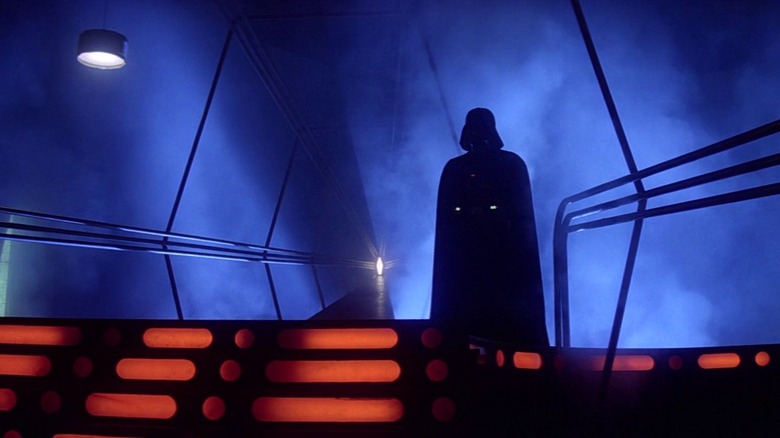The Most Flawless Sci-Fi Movie Scenes Of All Time
Impossible worlds. Transcendent mindscapes. Fantastical creatures. All these and more are hallmarks of the science fiction genre and reasons why it's so beloved. Sci-fi movies have the unique ability to transport us to whole other worlds — some enthralling in their majesty, others terrifying in their strangeness. And while not every film that attempts these things manages to pull them off, the sci-fi genre has left us with a ton of unforgettable moments over the decades.
As far back as silent films like the hugely influential "Metropolis," moviegoers have been fascinated by the capacity of science fiction to dazzle and explore. Whether you're a fan of the old black-and-white serials, the sci-fi boom of the late '70s and '80s, or more modern fare, you likely have at least a few experiences with the genre that have stayed with you long after the credits rolled. But which of those standout moments are the best of the best?
Out of love for the genre, we've assembled a list of some of the greatest and most memorable scenes it's ever given us.
The Death Star trench run - Star Wars
Debate has raged for decades over whether "Star Wars" truly counts as science fiction, or if it's more accurate to describe it as fantasy. Obviously, there are elements of both in George Lucas' immensely successful saga, but for our purposes, it's sci-fi. Sure, there are space wizards and religious doctrines, but the scene we're talking about here is about a team of space pilots taking down the greatest battle station in the galaxy.
The Death Star attack and trench run is one of the most iconic sequences in the history of film, period. Whether you've had the fortune to see the original, pre-CGI 1977 version or grew up on the still-great "special edition," this is a moment you won't be forgetting any time soon. It's arguably the most famous sequence in the entire "Star Wars" saga, and it set the tone at the very beginning for how a "Star Wars" space battle should look and feel. Lucas and his team famously drew inspiration from dog fights in World War II dramas, and that influence is palpable. The whole battle takes place in the open vacuum of space, yet every shot-down fighter and close engagement is packed with tight, frenetic energy.
Narratively, this scene is just as iconic. From Luke turning off his targeting computer for the impossible shot to Han flying in at the last second to save his skin, it's full of tropes in the best way. John Williams' triumphant score booms in the background, and the Death Star does the same.
Tears in Rain - Blade Runner
"I've seen things you people wouldn't believe. Attack ships on fire off the shoulder of Orion. I watched C-beams glitter in the dark near the Tannhäuser Gate." If you're a fan of sci-fi movies, these words are probably very familiar to you. Spoken by Rutger Hauer's Roy Batty at the end of Ridley Scott's neo-noir magnum opus "Blade Runner," this brief speech might be the most quoted and lauded monologue in the history of the genre.
In just 42 words, Batty sums up so much of the film's complexity. Rick Deckard (Harrison Ford) spends the entire film hunting Batty and his fellow rogue "replicant" androids. As a blade runner, that's his job. But as he and the viewer become more confused as to the nature of his own humanity, and as the clear injustice of replicant life become clearer, the story blurs. In the end, Batty saves Rick's life, and he chooses to spend his final moments sharing some of his unique experiences. There's an intangible blend of joy, sorrow, and wistfulness that Hauer delivers, poetically conveying what philosophical exposition couldn't possibly manage to do. Any life is a beautiful thing, and any death is a tragic one.
There are plenty of extratextual tidbits about this monologue as well, like how Hauer famously reworked the speech and improvised the most famous line, but you don't need to know that to appreciate it. The words speak for themselves. Batty's memories may be lost in time like tears in rain, but his monologue is forever immortalized.
The lighthouse - Annihilation
Some science fiction movies exist to ponder what could be — to consider the potential ramifications of theoretical technology and offer ideas of what they could mean. Others, like Alex Garland's critically acclaimed 2018 film "Annihilation," exist to do the opposite. Rather than offer possible answers to the looming questions of the universe, they merely create more mystery, utilizing the unique abilities of the genre to show impossible, inexplicable things.
The ending of "Annihilation" is one of the most beautiful, baffling, unnerving, and memorable moments in recent sci-fi history. Biologist Lena (Natalie Portman) spends the film journeying through a patch of wilderness surrounded by a strange energy field known as the shimmer, which has been slowly emanating outward from a crashed meteor. Within, the genes of all life have been scrambled in gorgeous and hideous ways. But that's nothing compared to what Lena finds in the lighthouse at the center of the Shimmer.
Lena discovers her lost squad leader, Dr. Ventress (Jennifer Jason Leigh), in the tower, who gives her a dark and cryptic warning. "It's inside me now," she says vaguely. "Our bodies and our minds will be fragmented into their smallest parts, until not one part remains. Annihilation." Ventress evaporates and becomes light. The light becomes a body, and the body becomes Lena. Under the haunting strangeness of Ben Salisbury and Geoff Barrow's musical score, Lena and her alien double engage in a dancelike duel with violent ends. It's cosmic horror at its truest and most powerful — a vision of alien life so different from ours that it defies explanation. Many have tried to explain the ending of "Annihilation," but the mystery is why it's so flawless.
Open the pod bay doors - 2001: A Space Odyssey
Calling "2001: A Space Odyssey" influential would be a dramatic understatement. Stanley Kubrick and Arthur C. Clarke's 1968 sci-fi epic basically defined an entire era for the genre, and it's still one of the most talked-about movies today. In truth, any number of scenes could be plucked from the film for this list. We could talk about the infamous Star Child ending, or the bizarre monolith sequences. But instead, let's talk about the scene that everybody loves to quote.
"Open the pod bay doors, please, HAL." That line itself is recognizable to many people who've never even seen the movie. It's the moment that our protagonist, astronaut Dave Bowman (Keir Dullea), realizes that his ship's A.I. isn't just sinister, but way, way ahead of him. "I know that you and Frank were planning to disconnect me," HAL says in his cold, unwavering, emotionless voice. "I could see your lips move."
"2001" is more about tone and atmosphere than it is about a straightforward story, and this scene is the ultimate example of that. The unsettling sound of HAL's mechanical voice, intercut with shots of the empty ship and the dark void of space, creates a sense of instant, unstoppable dread. Dave's own shots are claustrophobic, and we see the fear play out on his face as HAL shows his hand. In an age when A.I. technology is becoming a bigger part of our lives every day, this scene is even more foreboding than it was in 1968.
23 years - Interstellar
"Interstellar" isn't necessarily the most original sci-fi film of the 21st century, but that hasn't stopped it from becoming one of the most beloved. In style and tone, the film is very similar to the rest of Christopher Nolan's filmography. Thematically, it reads like a modern version of "2001: A Space Odyssey" — a movie that's fascinated with both the theoretical science and strangeness of space. However, "Interstellar" shines brightest in its most human moments. And if you've seen the movie, one scene in particular is probably leaping to mind right now.
In an effort to find new horizons for humanity, Joseph Cooper (Matthew McConaughey) and the rest of the Endurance team are tasked with visiting several different planets in orbit around the black hole Gargantua. Their first stop is an hour-long visit to an aquatic world that unfortunately brings nothing in the way of scientific revelation. Due to miscalculations of the black hole's time dilation and an unforeseen tragedy on the planet's surface, Cooper and Dr. Amelia Brand (Anne Hathaway) return to the Endurance to find that 23 years have passed.
The moment is enough to wreck you. Before the mission even really gets started, the crew is broken. As Cooper watches two decades of backlogged video messages from his now-grown children, he completely breaks down. The music from Hans Zimmer — a composer famous for sweeping anthems and soaring strings — is quiet here, as if it too has been hushed by the terrifying vastness and power of space.
The multiverse montage - Everything Everywhere All at Once
It's not every year that we get a new film worthy of the sci-fi cinema pantheon, but 2022 brought an instant classic with "Everything Everywhere All at Once." The hilarious, emotional, and infinitely creative family drama from directors Daniel Kwan and Daniel Scheinert is the rare film that occupies a space all its own. Even in the modern crowd of multiverse movies, "Everything Everywhere All at Once" stands head and shoulders above the rest.
The movie is a non-stop rollercoaster of bizarre alternate realities and exciting martial arts action, all anchored by a powerful story about the things we give up for the people we love. In the third act, though, things really kick into high gear. Michelle Yeoh's Evelyn fully locks into the multiverse she's been accessing and starts racing through it at a fever pitch, leading to a stunning montage of different realities flashing by her in an instant. It's a perfect encapsulation of the film's unique style and a moment that leaves a lasting impression. Everything from animated universes to celestial landscapes and snowy city streets flash by while the camera stays rooted firmly on Evelyn's face. We see the infinite possibilities of her life, and we feel the weight of the decisions she's made.
Though the montage itself only lasts a moment, it leads to an equally frenetic final act with plenty of other wild scenes. "Everything Everywhere All at Once" beautifully balances chaos with grounded emotion, and it all comes together flawlessly at the end.
The kick - Inception
In 2010, hot off the star-making success of "The Dark Knight," Christopher Nolan dropped an original sci-fi masterpiece that took the world by storm. "Inception" was a success on many levels, achieving high marks from critics and raking in cash at the box office with a star-studded cast led by Leonardo DiCaprio, Joseph Gordon-Levitt, Marion Cotillard, and Elliot Page. It also introduced a sound effect that has haunted blockbuster trailers ever since.
Because the dream-sharing technology at the center of "Inception" is so high-concept, it's easy to forget that the film is still, at its heart, a heist movie. But when you hit the climax, that becomes pretty clear. After diving down into the forbidden third level of target Robert Fischer's (Cillian Murphy) dream world, the crew prepares for extraction. To get out, they trigger "kicks" — weightless moments that wake dreamers — in all three active dream levels at once. This causes time, gravity, and the very fabric of "reality" to unravel in different ways across the different layers, resulting in one of the most intense, unique, and impressively shot sci-fi action sequences ever.
Each level is its own distinct set piece: The crew's van driving off a bridge into a river, Arthur (Gordon-Levitt) battling foes in a hotel without gravity, and the rest of the gang basically doing a "Call of Duty" level at a snowy military base. But it's the way these three scenes influence each other that elevates the whole thing to another level.
Music of the stars - Close Encounters of the Third Kind
If you were worried this list would be devoid of Steven Spielberg movies, rest easy. Many of the illustrious director's most famous films fall into the sci-fi genre, including 1977's "Close Encounters of the Third Kind" — Spielberg's first movie after breaking out as a blockbuster director with "Jaws" in 1975. "Close Encounters" is a movie all about aliens, but it plays out more like a mystery than a straightforward drama or action movie. In fact, there's very little action to speak of at all, even when humanity finally makes contact with the extraterrestrials.
The ending of "Close Encounters" is as beautiful as it is mystifying. The aliens finally touch down in Wyoming, where the U.S. military has laid out a welcome party. To communicate, the humans use a combination of light patterns on a giant screen and musical notes inspired by the aliens' own strange sounds. In this way, the two species are able to communicate, though it's still a bit unclear what the conversation entails.
But then, that's kind of the point. The audiovisual communication with the aliens is tonally perfect, maintaining the alluring mystique of the rest of the film while also offering a satisfying resolution. We don't get concrete answers about what the aliens have done, or what they want, but we do get a powerful, resonant moment of connection between two corners of the universe. Even decades later, the scene is absolutely breathtaking.
The final duel - Predator
A lot of the best moments in sci-fi movie history are scenes that challenge viewers intellectually, giving form to impossible things or exploring mind-blowing ideas. Some, though, are great simply because it's fun to see big, beefy dudes fight aliens with knives in the jungle.
"Predator" may not be the most thought-provoking science fiction movie, but it is a certified classic. The first action movie from director John McTiernan, who later conquered the genre with the "Die Hard" franchise, follows a squad of muscle-bound military commandos on a routine mission into a South American jungle. Things go awry when they start to be hunted by an invisible extraterrestrial foe: the Predator itself.
By the time the final act rolls around, it's just Dutch (Arnold Schwarzenegger) and the Predator. Slathered in mud to avoid the alien's thermal vision, Dutch lays traps, ambushing his enemy in the same way it's been taking out his comrades. Sparks fly (literally), and the jungle lights up with fire and explosions as the two titans go at it. We even get a few choice one-liners along the way to keep things light.
Sometimes, a great scene doesn't need to tap into the deepest recesses of your mind. Sometimes, it just needs to be flashy and fun, and the ending of "Predator" is exactly that. The duel in the 2022 prequel "Prey" may be even better, but we'll leave that up to you to decide.
Neo unlocks his true powers - The Matrix
"What are you trying to tell me? That I can dodge bullets?" Neo (Keanu Reeves) asks Morpheus (Lawrence Fishburne) during a training scene early on in "The Matrix. "No, Neo," his teacher responds. "I'm trying to tell you that when you're ready, you won't have to."
There are a lot of things to love about the Wachowski sisters' breakout sci-fi masterpiece, from the stunning visual style and rip-roaring action to the heady A.I. storyline. And in truth, many different moments could justify spots on this list. The red-pill-blue-pill scene, for instance, or the slow-mo lobby shootout that kicks off the final act. But one moment stands tall above the rest: When Neo finally unlocks his true potential.
After seemingly being killed by Agent Smith (Hugo Weaving) and his compatriots, it looks like Neo might not be the one after all. But a real-world kiss from Trinity (Carrie-Anne Moss) gives him a second wind, and when he stands up, he's a very different man. Just as foretold by Morpheus, Neo blocks the agents' bullets like they're nothing. And when Smith comes in for a closer attack, he remains equally untouchable. Suddenly, the most dangerous forces in the Matrix are reduced to frightened children, and Neo finishes Smith off with an explosive display of his reality-altering power. This moment is only made better by the final shot of the film, in which Neo takes flight for the first time.
Light Cycles - Tron: Legacy
"Tron" might not have been a huge success in 1982, but it's become a cult classic since, and it's an incredibly important film. It was one of the first feature films to use CGI in a major way, which fit perfectly with its experimental cyber-world setting (via The Guardian). The most famous action set piece from the film today is probably the Light Cycle battle sequence — a combat racing scene that was incredibly ambitious for its time.
Decades ago, the original "Tron" might have made it on this list with its Light Cycles. Sadly, the scene hasn't aged especially well, but fans got a renovated version in 2010's "Tron: Legacy." In an interview that same year with Den of Geek, Steven Lisberger — who directed the original film and was a producer on the sequel — said that the Light Cycles in "Tron: Legacy" looked "much more like we'd hoped" in the early '80s. The same could be said of the entire Light Cycle battle.
In "Tron: Legacy," the combat race is nearly operatic, anchored and elevated by Daft Punk's stellar soundtrack. Every movement is timed to the music, creating a scene that's more like a cyberspace music video than a typical action set piece. While it may not be the most important moment in the movie's overall narrative, the Light Cycle battle is everything it needs to be. It's great to see a classic scene revitalized so well, and the score is just the icing on the cake.
The storm - Mad Max: Fury Road
It's generally ill-advised to start your production with a show-stopper — where can you go from there? But when that movie is as incredible as "Mad Max: Fury Road," you can get away with it. George Miller's 2015 film isn't just a sequel to his classic trilogy from decades earlier: It's a partial reboot and quasi-reimagining that incorporates elements from every prior film, including the iconic tanker chase from "The Road Warrior" (itself a contender for inclusion on this list) and the wacky post-apocalypse characters from "Beyond Thunderdome."
Picking a single moment from "Fury Road" to include is tough because the film is basically one long chase scene. However, there probably isn't a more memorable sequence than the sandstorm battle in the first act. From the pull-out shot that shows the gargantuan size of the storm to the final shot of Nux's (Nicholas Hoult) flare burning out into darkness, the whole sequence is breathtaking. It's the perfect way to convey the natural brutality of this world and the fragility of human life within it.
Perhaps the most terrifying thing about this awe-inspiring scene is that it's not as far as you might think outside the realm of possibility. Speaking with the Argonne National Laboratory, U.S. Department of Energy climate scientist Doug Sisterson said that lightning can occur within large dust storms due to the friction of particles, just as is shown in the film. Sisterson also said that the movie is "symbolic of the types of social issues we may face due to extreme weather events." In a word, yikes.
The bike ride - E.T. the Extra-Terrestrial
For movie fans of a certain age, "E.T." is the quintessential alien movie. It's untouchable in its simplicity — the story of a young boy (Henry Thomas) who finds, befriends, and fights to protect a gentle extraterrestrial left behind by his people. With Steven Spielberg's impeccable direction and John Williams' triumphant score, the film takes this basic pitch and makes it a deeply emotional journey. And of course, it also features perhaps the most famous shot in the history of film.
You already know the one. With E.T. bundled in a blanket on the front of his bike, Elliott goes for an evening ride. And thanks to the alien's supernatural powers, they're able to take flight. The shot of the bike crossing in front of the moon might as well be the logo for Hollywood blockbusters, even decades after it first dazzled audiences. Williams' music soars in the background, just as E.T. and Elliott fly before our eyes. It's the kind of scene that's made Spielberg one of the most lauded directors of all time, and it just might be his finest moment.
First contact - Alien
Ridley Scott's "Alien" is one of the most beloved and influential films in the entire sci-fi genre, both for its masterfully implemented horror elements and its dense environmental worldbuilding. Most of the action takes place on the Nostromo, a mining ship on its way back to Earth that's infiltrated by a deadly alien predator called a xenomorph. The hunting (and subsequent avoiding) of the monster make for some great, tense scenes, but the moment we've chosen for this list happens closer to the start of the film.
The whole reason that the xenomorph gets on board at all is that the ship receives a signal from a nearby moon. Weylan-Yutani company policy demands that the crew investigate, leading to a gorgeously unsettling expedition onto an alien spacecraft.
From the stark landscapes of the moon itself to H. R. Giger's designs for the alien ship, this whole sequence oozes atmosphere and dread. It captures the otherworldly nature of what's about to happen flawlessly, and things only get more unsettling when the first "facehugger" appears. There are plenty of other horrifying moments in "Alien," like the "chestburster" and Ash's (Ian Holm) milky android reveal, but the whole tone is set during this first-contact sequence. Without directly explaining anything, the film effortlessly conveys the terrifying strangeness of the universe, which is the whole point. After all, in space, no one can hear you scream.
Luke vs. Vader - The Empire Strikes Back
The "Star Wars" franchise is so important to the sci-fi genre at large that it earns two entries on this list. And there should be no doubt that "The Empire Strikes Back" is deserving, as many regard it as the best movie in the entire series. From the snowy battle on Hoth in the first act to Yoda's Jedi teachings on Dagobah, the film is loaded with memorable moments, but the sequence we've chosen is particularly significant. And yes, it's the one you're thinking of.
"Star Wars" is nothing if not loyal to narrative traditions, and the showdown between Luke Skywalker and Darth Vader on Cloud City is about as "hero's journey" as it gets. George Lucas was a huge fan of Joseph Campbell's writings on storytelling and hero myths, and he brought that adoration to bear in "Empire Strikes Back," delivering the quintessential "ordeal," to use Campbell's language, with the climactic lightsaber duel.
It's easily the best saber fight in the original "Star Wars" trilogy, and it ends with one of cinema's most memorable plot twists. As Vader holds out his hand to his son, promising wealth and power if they join forces, we see in Luke's eyes a combination of terror and hate. And yet, he dodges the dark side, instead letting himself fall for his friends to catch. It's a moment that's been done a hundred times in a hundred stories, but it's never been more iconic than in "Star Wars."
